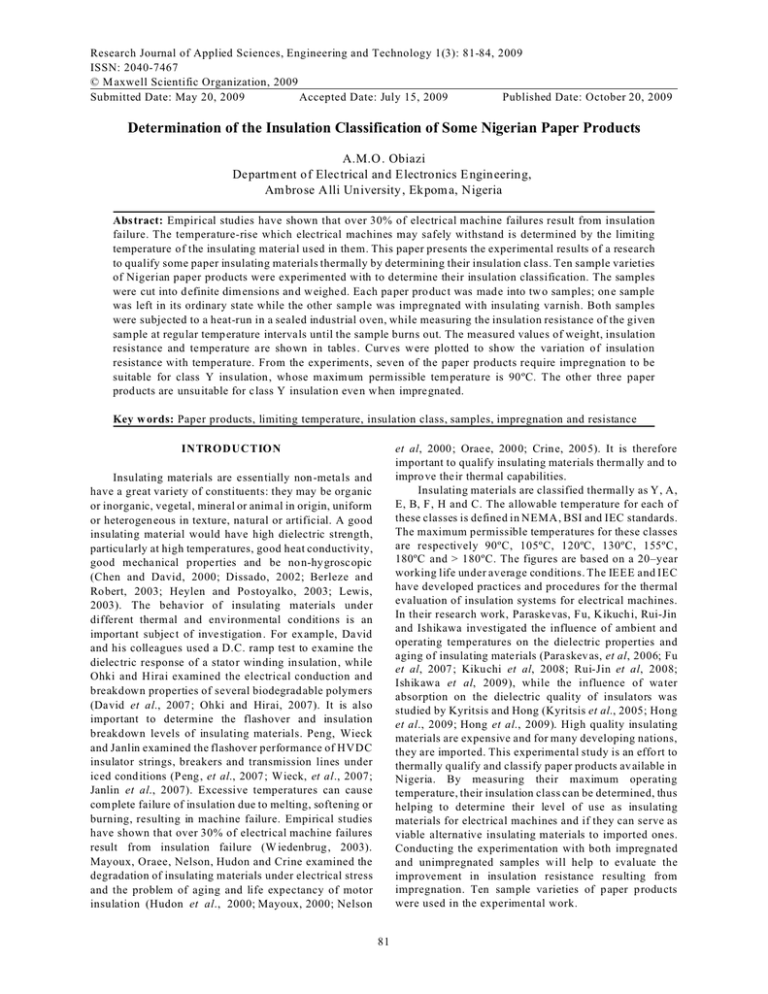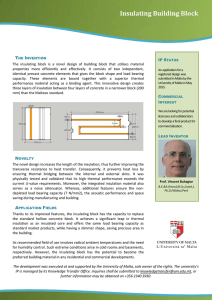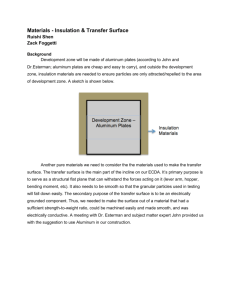Research Journal of Applied Sciences, Engineering and Technology 1(3): 81-84,... ISSN: 2040-7467 © M axwell Scientific Organization, 2009
advertisement

Research Journal of Applied Sciences, Engineering and Technology 1(3): 81-84, 2009 ISSN: 2040-7467 © M axwell Scientific Organization, 2009 Submitted Date: May 20, 2009 Accepted Date: July 15, 2009 Published Date: October 20, 2009 Determination of the Insulation Classification of Some Nigerian Paper Products A.M.O . Obiazi Departm ent of Electrical and Electronics E ngin eering, Am brose Alli University , Ekpom a, Nigeria Abstract: Empirical studies have shown that over 30% of electrical machine failures result from insulation failure. The temperature-rise which electrical machines may safely withstand is determined by the limiting temperature of the insulating material used in them. This paper presents the experimental results of a research to qualify some paper insulating materials thermally by determining their insulation class. Ten sample varieties of Nigerian paper products were experimented with to determine their insulation classification. The samples were cut into d efinite dim ensions and weighe d. Each pa per pro duct was mad e into tw o sam ples; on e sam ple was left in its ordinary state while the other sample was impregnated with insulating varnish. Both samples were subjected to a heat-run in a sealed industrial oven, while measuring the insulation resistance of the given sample at regular temp erature intervals until the sample burns out. The measured values of weight, insulation resistance and tempe rature are shown in tables. Curv es w ere plotted to show the variation of insulation resistance with temperature. From the experiments, seven of the paper products require impregnation to be suitable for class Y insulation, whose m aximum perm issible tem peratu re is 90ºC. The oth er three paper products are unsu itable for c lass Y insulation eve n when impregnated. Key w ords: Paper products, limiting temperature, insulation class, samples, impregnation and resistance et al, 2000 ; Orae e, 200 0; Crin e, 200 5). It is therefore important to qualify insulating materials therm ally and to impro ve their thermal capabilities. Insulating materials are classified thermally as Y, A, E, B, F, H and C. The allowable temperature for each of these classes is defined in NEMA, BSI and IEC standards. The maximum permissible temperatures for these classes are respectively 90ºC, 105ºC, 120ºC, 130ºC, 155ºC, 180ºC and > 180ºC. The figures are based on a 20–year working life under average conditions. The IEEE and IEC have developed practices and procedures for the thermal evaluation of insulation systems for electrical machines. In their research work, Paraskevas, Fu, Kikuch i, Rui-Jin and Ishikawa investigated the influence of ambient and operating temperatures on the dielectric properties and aging of insulating materials (Para skev as, et al, 2006; Fu et al, 2007 ; Kiku chi et al, 2008; Rui-Jin et al, 2008; Ishikawa et al, 2009), while the influence of water absorption on the dielectric quality of insulators was studied by Kyritsis and Hong (Kyritsis et al., 2005; Hong et al., 2009; Hong et al., 2009). High quality insulating materials are expensive and for many developing nations, they are imported. This experimental study is an effo rt to therm ally qualify and classify paper products av ailable in Nigeria. By measuring their maximum operating temperature, their insulation class can be determined, thus helping to determine their level of use as insulating materials for electrical machines and if they can serve as viable alternative insulating materials to imported ones. Conducting the experimentation with both impregnated and unimpregnated samples w ill help to evaluate the improvement in insulation resistance resulting from impregnation. Ten sample varieties of paper p roducts were used in the experimental work. INTRODUCTION Insulating materials are essentially non -metals and have a great variety of constituents: they may be org anic or inorganic, vegetal, mineral or anim al in origin, uniform or heterogen eous in texture, na tural or artificial. A good insulating material would have high dielectric strength, particularly at high temperatures, good heat conductivity, good mecha nical properties and be no n-hygrosc opic (Chen and David, 2000; Dissado, 2002; Berleze and Robert, 2003; Heylen and Po stoyalko, 2003; Lewis, 2003). The behavior of insulating materials under different thermal and environmental conditions is an important subjec t of investigation . For ex amp le, David and his colleagues used a D.C. ramp test to examine the dielectric response of a stator winding in sulation , while Ohki and Hirai examined the electrical conduction and breakdown properties of several biodegrad able polym ers (David et al., 2007 ; Ohki and Hirai, 2007). It is also important to determine the flashover and insulation breakdown levels of insulating materials. Peng, Wieck and Janlin examined the flashover performance of HVDC insulator strings, breakers and transmission lines under iced cond itions (Peng, et al., 2007 ; W ieck, et al., 2007; Janlin et al., 2007). Excessive temperatures can cause com plete failure of insulation due to melting, softening or burning, resulting in machine failure. Empirical studies have shown that over 30% of electrical machine failures result from insulation failure (W iedenbrug , 2003). Mayoux, Oraee, Nelson, Hudon and Crine examined the degradation of insulating m aterials under electrical stress and the problem of aging and life expectancy of motor insulation (Hudon et al., 2000; Mayoux, 2000; Nelson 81 Res. J. Appl. Sci., Eng. Technol., 1(3): 81-84, 2009 MATERIALS AND METHODS The paper products used in the experiments were: C C C C C C C C C C Carton paper Newsprint Emboss wood Chipb oard Manila paper Glossy paper 80 gram paper 60 gram paper Strawb oard Emboss card. Fig 1: The Inner chambers of the oven Preparation of the Pap er Sam ples: Each paper sample measured 10cm x 5cm . The thickness of each type of paper was maintained as manufactured in order not to alter the integrity of the paper material. Each of the ten paper materials was made into two samples, with one sample impregnated and the other unimpregnated. The sample to be impregnated was immersed in hot insulating varnish for ten hours and then dried slow ly for two days. The weight of the samples before impregnation, immediately after impregnation, and after drying as well as the initial insulation resistance (at room temperature) of both samples of each paper material are shown in Table 1. Heat Run: The two samples of each of the ten paper materials were subjected to a heat-run in a well- lagged industrial oven shown in Fig 1. The insulation resistance of the samples were measured at regular tempe rature intervals of 20ºC until the given samp le burn s out. Table 2 shows the insulation resistance measurement of the paper materials during the heat- run. Fig 2a: Insulation resistance versus temperature RESULTS AND DISCUSSION Fig. 2 (a, b, c and d) are curves of the insulation resistance versus temperature for the impregnated samples of the ten paper products. From Table 2, it is clearly seen that all the paper products were burnt at 110ºC, whether impregnated or not. Seven impregnated samples of the paper products (Carton paper, Emboss wood, Chipboard, Manila paper, Gloss paper, Strawboard, and Emboss card) had insulation resistance up to 8MS at 90 ºC, which is the limiting temperature for class Y insu lation. Thus, they are suitable for class Y insulation when impregnated . The other three impregnated paper products (newsprint, 80 gram paper and 60 gram paper) had insulation resistance of 4M S at 90ºC and so are unsuitable for class Y insulation even when impregnated. All the ten unimpregnated samples of the paper products had insulation resistance below 5M S at 90 ºC. It implies that none of the paper products can be used for class Y insulation w ithout im pregnation . Fig 2b: Insulation resistance versus temperature 82 Res. J. Appl. Sci., Eng. Technol., 1(3): 81-84, 2009 Table 1: Initial Parameters of the Paper Samples Weight of Samples (g) --------------------------------------------------------------------Paper Sam ples Befo re Imm edia tely After drying Varnishing after Varnishing Carton 5.426 9.005 8.805 Newsprint 0.240 0.605 0.514 Emboss wood 1.311 2.005 1.868 Ch iboard 1.236 1.492 1.400 M anila 1.148 1.386 1.321 Gloss paper 0.894 1.002 0.999 80 grams 0.401 0.521 0.492 60 grams 0.295 0.355 0.300 Straw board 4.458 4.999 4.799 Em boss C ard 1.013 1.650 1.590 Insulation Resistan ce (M S) ------------------------------------------------------------Impregnated Unimpregnated 200 200 200 200 200 200 200 200 200 200 Table 2: Heat Run and Insulation Resistance Measurement of Wood Samples (V= varnished nV= non- varnished) 30ºC 50ºC 70ºC 90ºC -------------------------------------------------------------------------------------------Pap er M aterials V MS n V MS V MS n V MS V MS n V MS V MS n V MS Carton 150 50 100 20 40 10 8.5 3 Newsprint 150 75 75 30 20 12 4 1.8 Emboss wood 150 75 100 30 50 10 8.5 4 Ch iboard 150 75 100 20 40 10 8.5 4.5 M anila 150 75 100 40 50 20 8 2 Gloss paper 150 50 100 20 40 9 8 1.5 80 grams 150 75 75 40 40 10 4 0.8 60 grams 150 75 75 30 30 10 4 0.8 Straw board 150 75 100 40 30 20 8 1.4 Em boss C ard 150 75 100 40 50 20 8 1.6 Fig 2c: Insulation resistance versus temperature 100 200 200 200 200 150 200 200 200 200 110ºC --------------------------------V MS n V MS Fig 2d: Insulation resistance versus temperature CONCLUSION REFERENCES The results of the research show that all the ten paper products used in the experimentation cannot be used for even class Y insulation without impregnation. How ever, seven of the paper products (Carton paper, Emboss wood, Chipboard, Manila paper, Gloss paper, Strawboard, and Emboss card) are suitable for class Y insulation when impregnated. The other three paper products (N ewsprint, 80 gram pape r, 60 gram pa per) are unsu itable for class Y insulation w hethe r impregnated or not. Berleze, S.L.M . and R. Robert, 2003 Response functions and after-effects in dielectrics, Institute of Electrical and Electronics Engineers (IEEE) Transactions on Dielectrics and Electrical Insulation (TDEI), 0(4): 66 5-669. Chen, G. and A.E. Davies, 2000. The influence of defects on the short-term breakdown characteristics and long-term dc performance of LDPE insulation, ibid, 7(3): 40 1-407. 83 Res. J. Appl. Sci., Eng. Technol., 1(3): 81-84, 2009 Crine , J.P., 2005. Influen ce of electro mechanical stress on electrical properties of dielectric polymers, Ibid, 12(4): 791-800. David, E., T. Godin, J. Bellemare and L. Lamarre, 2007. Modeling of the D ielectric response of a Stator W inding Insulation from a DC R amp Test, Ibid, 14(6): 1548 -1558. Dissado, L.A., 2002. Predicting electrical breakdown in polym eric insulators. From determ inistic mechanisms to failure statistics, Ibid, 9(5): 860-875. Fu, M., G. Chen, L.A. Dissado and J.C. Fothergill, 2007. Influence of thermal treatment and residues on space charge accumulation in XL PE fo r DC pow er cable application, Ibid, 14(1): 53-64. Heylen, A.E .D. an d V. Postoyalko, 20 03. Intrinsic dielectric strength of dense pure hydrocarbons including polythene, Ibid, 10(4): 708-714. Hong, T.P., O. Lesaint and P. Gonon, 2009. Water absorption in a glass-mica-epoxy composite(I:Influence on electrical properties), Ibid, 16(1): 1-10. Hong, T.P., P. Gonon and O. Lesaint, 2009. Water absorption in a glass-mica-epo xy co mpo site (II: Field distribution and diagnostic in a stator bar geom etry), Ibid, 16(1): 11-16. Hudon, C., N. Amyot, T. Lebey, P. Castelan and N. Kandev, 2000. Testing of low voltage mo tor turn insulation intended for pulse-width modulated applications, Ibid, 7(6): 783-789. Ishikawa T., K. Yasuda, T. Igarashi, S. Yanabu, G. Ueta and S. Oka be, 2009 . Effect of temperature on the streaming electrification characteristics of silicone oil, Ibid, 16(1): 273-280. Jianlin,, H, S. Caixin, J. Xingliang and S. Lichun, 2007. Flashover performance of pre-contaminated and icecovered composite insulators to be used in 1000KV UHV AC transmission lines, Ibid, 14(6): 1347-1356. Kikuchi, Y., T. Murata, Y. Uozumi, N . Fukumoto, M. Nagata ,Y. Wakimoto and T. Yoshimitsu, 2008. Effects of ambient humidity and temperature on partial discharge characteristics of conventional and nano composite enameled magnet wires, Ibid, 15(6): 1617 -1625. Kyritsis, A., M. Siakantari, A. Vassilikou-Dova, P. Pissis and P. Varotsos, 2000. Dielectric and electrical properties of polycrystalline rocks at various hydration levels, Ibid, 7(4): 493-497. Lewis, T.J., 2003. Breakdown initiating mechanism s at electrode interfaces in liquids, ibid, 10(6): 948-955. Mayoux, C., 2000. Degradation of insulating materials under electrical stress, Ibid, 7(5): 590-601. Nelson, J.K., S. Azizi-Ghannad and L. Hong, 2000. Theory and application of dynam ic aging for life estimation in machine insulation, Ibid, 7(6): 773-782. Ohki, Y. and N. Hirai, 2007. Electrical conduction and breakdown properties of several biodeg radab le polymers, Ibid, 14(6): 1559-1566. 84






